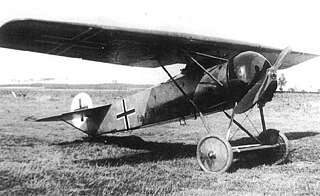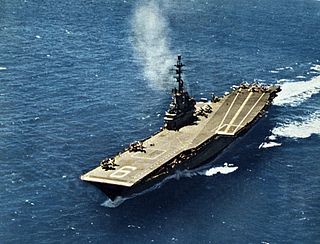Ship commissioning is the act or ceremony of placing a ship in active service and may be regarded as a particular application of the general concepts and practices of project commissioning. The term is most commonly applied to placing a warship in active duty with its country's military forces. The ceremonies involved are often rooted in centuries-old naval tradition.

Aeroelasticity is the branch of physics and engineering studying the interactions between the inertial, elastic, and aerodynamic forces occurring while an elastic body is exposed to a fluid flow. The study of aeroelasticity may be broadly classified into two fields: static aeroelasticity dealing with the static or steady state response of an elastic body to a fluid flow; and dynamic aeroelasticity dealing with the body's dynamic response.

The Fokker E.V was a German parasol-monoplane fighter aircraft designed by Reinhold Platz and built by Fokker-Flugzeugwerke. The E.V was the last Fokker design to become operational with the Luftstreitkräfte, entering service in the last months of World War I. After several fatal accidents due to wing failures, the aircraft was modified and redesignated Fokker D.VIII. Dubbed the Flying Razor by post-war pulp-fiction writers, the D.VIII had the distinction of scoring the last aerial victory of the war.

The Heinkel He 274 was a German heavy bomber design developed during World War II, purpose-designed for high-altitude bombing with pressurized crew accommodation. Due to the Allied advance through Northwest Europe, the prototypes were abandoned at the French factory where they were being built. They were completed after the war by the French and used for high-altitude research.

The flight deck of an aircraft carrier is the surface from which its aircraft take off and land, essentially a miniature airfield at sea. On smaller naval ships which do not have aviation as a primary mission, the landing area for helicopters and other VTOL aircraft is also referred to as the flight deck. The official U.S. Navy term for these vessels is "air-capable ships".

The lead ship, name ship, or class leader is the first of a series or class of ships all constructed according to the same general design. The term is applicable to naval ships and large civilian vessels.

The Fairey Gannet is a carrier-borne aircraft that was designed and produced by the British aircraft manufacturer the Fairey Aviation Company. It was developed for the Royal Navy, being the first fixed-wing aircraft to combine both the search and strike portions of anti-submarine warfare (ASW) operations to be operated by the Fleet Air Arm (FAA).

The Convair XFY Pogo was an experiment in vertical takeoff and landing (VTOL) tail-sitter. The Pogo had delta wings and three-bladed contra-rotating propellers powered by a turboprop engine. It was intended to be a high-performance fighter aircraft capable of operating from small warships. Landing the XFY-1 was difficult, as the pilot had to look over his shoulder while carefully working the throttle to land.

A type certificate signifies the airworthiness of a particular category of aircraft, according to its manufacturing design. Certification confirms that the aircraft of a new type intended for serial production, is in compliance with applicable airworthiness requirements established by the national air law.
Flight testing is a branch of aeronautical engineering that develops specialist equipment required for testing aircraft behaviour and systems. Instrumentation systems are developed using proprietary transducers and data acquisition systems. Data is sampled during the flight of an aircraft, or atmospheric testing of launch vehicles and reusable spacecraft. This data is validated for accuracy and analyzed before being passed to specialist engineering groups for further analysis to validate the design of the vehicle.

An electronic flight bag (EFB) is an electronic information management device that helps flight crews perform flight management tasks more easily and efficiently with less paper providing the reference material often found in the pilot's carry-on flight bag, including the flight-crew operating manual, navigational charts, etc. In addition, the EFB can host purpose-built software applications to automate other functions normally conducted by hand, such as take-off performance calculations. The EFB gets its name from the traditional pilot's flight bag, which is typically a heavy documents bag that pilots carry to the cockpit.

The Supermarine Seagull was a British amphibious, military flying boat and the last to be built by the Supermarine company. Design started during the Second World War but it did not fly until three years after the war had ended and the project was cancelled without it being adopted for service.

The Supermarine Seagull was a amphibian biplane flying boat designed and produced by the British aircraft manufacturer Supermarine. It was developed from the experimental Supermarine Seal II.

USS Barbey (DE-1088/FF-1088) was a Knox-class frigate of the US Navy. Barbey (DE-1088) was laid down on 5 February 1972 by Avondale Shipyards, Inc., Westwego, La.; launched on 4 December 1971; sponsored by Mrs. Daniel E. Barbey, widow of Vice Admiral Barbey; and placed in commission at Long Beach Naval Shipyard on 11 November 1972.

Shakedown cruise is a nautical term in which the performance of a ship is tested. Generally, shakedown cruises are performed before a ship enters service or after major changes such as a crew change, repair or overhaul. The shakedown cruise simulates working conditions for the vessel, for various reasons. For most new ships, the major reasons are to familiarise a crew with a new vessel and to ensure all of the ship's systems are functional.

In aviation, airworthiness is the measure of an aircraft's suitability for safe flight. Initial airworthiness is demonstrated by a certificate of airworthiness issued by the civil aviation authority in the state in which the aircraft is registered, and continuing airworthiness is achieved by performing the required maintenance actions.

China Airlines Flight 120 was a regularly scheduled flight from Taiwan Taoyuan International Airport in Taoyuan County, Taiwan to Naha Airport in Okinawa, Japan. On August 20, 2007, the Boeing 737-800 aircraft operating the flight caught fire and exploded after landing and taxiing to the gate area at Naha Airport. Four people—three from the aircraft and one ground crew—sustained injuries in the accident. The fire had been caused by a loose bolt puncturing a fuel tank.

Seakeeping ability or seaworthiness is a measure of how well-suited a watercraft is to conditions when underway. A ship or boat which has good seakeeping ability is said to be very seaworthy and is able to operate effectively even in high sea states.

The ASW Continuous Trail Unmanned Vessel (ACTUV) is a DARPA funded project launched in early 2010 to develop an anti-submarine drone. ASW is an acronym for Anti-Submarine Warfare. In January 2018 after successful sea trials it was announced that the "Sea Hunter" prototype has transitioned from DARPA to the Office of Naval Research for further development.

The Bundeswehr Technical and Airworthiness Center for Aircraft or is one of several testing centres of the German Armed Forces. Its tasks are the testing and evaluating of military aircraft and aerial weapon systems. The centre is also responsible for certifications and inspections of modifications made on aircraft already in service with the German Armed Forces. The Bundeswehr Technical and Airworthiness Center for Aircraft is not integrated into the command structure of the military branches of the German Armed Forces but is a branch of Federal Office of Bundeswehr Equipment, Information Technology and In-Service Support which is directly subordinate to the Federal Ministry of Defence. Founded in 1957, the centre is based at Manching Air Base. The unit has a strength of about 650 personnel, 50 of which are members of the armed forces, the rest are civilian.


















